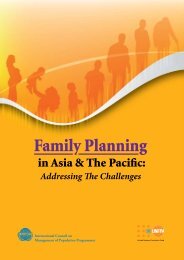SRH and HIV/AIDS Linkages at Policies, Programmes and Service ...
SRH and HIV/AIDS Linkages at Policies, Programmes and Service ...
SRH and HIV/AIDS Linkages at Policies, Programmes and Service ...
Create successful ePaper yourself
Turn your PDF publications into a flip-book with our unique Google optimized e-Paper software.
Dr Naresh Pr<strong>at</strong>ap KC, Director, Family Health Division, Ministry of Health <strong>and</strong>Popul<strong>at</strong>ion, NepalFamily Planning has been integr<strong>at</strong>ed with m<strong>at</strong>ernal <strong>and</strong> child health since the 3rd FiveYear Plan (1965-70). Currently, there are almost 50,000 female community healthvolunteers, in 97% of rural healthcare facilities to provide primary health care services<strong>and</strong> referrals for family planning <strong>and</strong> m<strong>at</strong>ernal <strong>and</strong> child health services (WHO, 2008).However, the availability of family planning service, particularly surgical contraceptionservices in several service sites, is low. Although, linkage between family planning<strong>and</strong> MCH has been effective, to a certain extent, linkages with other services such assafe motherhood, post-abortion <strong>and</strong> safe abortion care are still lacking. Providers havementioned th<strong>at</strong> integr<strong>at</strong>ion has overburdened service providers in hospitals, primaryhealth care <strong>and</strong> among the female community health volunteers.Dr Pr<strong>at</strong>ap also highlighted the public-priv<strong>at</strong>e partnership in health sector in Nepal, whichthe purpose is to increase particip<strong>at</strong>ion of priv<strong>at</strong>e sectors/NGOs in safe motherhoodrel<strong>at</strong>ed services. These include capacity building for safe motherhood rel<strong>at</strong>ed services,skilled birth <strong>at</strong>tendance training, social mobiliz<strong>at</strong>ion of contraceptives <strong>and</strong> familyplanning commodities, <strong>and</strong> collabor<strong>at</strong>ion with priv<strong>at</strong>e healthcare providers to provideComprehensive Essential Obstetric Care (CEOC) services .Lessons learned from the public-priv<strong>at</strong>e partnership are:• Involving the community during the planning of HF helps in developing ownershipamong the community <strong>and</strong> easy to make the site functional• Making availability of quality care, free delivery service <strong>and</strong> providing transportincentive does encourage women to have institutional delivery• Programs <strong>at</strong> the community to cre<strong>at</strong>e awareness <strong>and</strong> making service available in thehealth facility simultaneously will support in improving safe motherhood st<strong>at</strong>us• Working in close collabor<strong>at</strong>ion <strong>and</strong> support from EDPs has proven to bring changesin the MNH st<strong>at</strong>usIntroductionⅵ (f)














